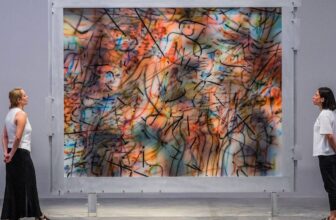What Are John Baldessari’s Most Famous Paintings
In the ever-evolving world of contemporary art, where visual language merges with philosophical ideas, one name stands out as a beacon of irreverent brilliance: John Baldessari. A maverick conceptual artist, Baldessari changed how we view painting, photography, and even the very definition of art itself. Often referred to as the godfather of conceptual art, Baldessari’s influence is deeply etched in the postmodern art landscape, his works speaking with humor, irony, and intellect.
From painted dots covering faces in old photographs to texts turned into art, Baldessari created a visual language entirely his own. But what exactly makes his paintings so iconic? How were they made, what do they cost today, and where are they displayed? This story will dive deep into the life, legacy, and labyrinthine creativity of John Baldessari, offering a narrative journey through the world of one of the most celebrated artists of the 20th and 21st centuries.
The Man Behind the Dots: A Brief Biography
Born in National City, California in 1931, John Baldessari began his career in a rather traditional way, painting in oils, experimenting with abstraction, and teaching art. But in 1970, he made a decision that would define the rest of his artistic journey: he cremated all the paintings he had made between 1953 and 1966. This act was not just symbolic, it was revolutionary.
The cremation of his earlier work was Baldessari’s dramatic statement of reinvention, rejecting traditional methods and embracing conceptual art. From that point on, he began integrating text, photography, video, and found imagery into his work, always questioning what art is, what it can be, and how it can function.
He quickly became a central figure in the Conceptual Art movement, revered not just for his creations but also for his role as a teacher at the California Institute of the Arts (CalArts), where he mentored future legends like David Salle, Mike Kelley, and Tony Oursler.
What Was John Baldessari Known For?
John Baldessari is best known for his playful yet cerebral art that merges images with text to question artistic conventions, media representations, and viewer expectations. His signature motifs include:
Colorful dots over faces in photographs
Juxtapositions of image and language
Witty or absurd captions
Use of found images from film stills, advertisements, and newspapers
Large-scale photo composites
His ability to transform mundane or discarded imagery into poignant, funny, or even absurd commentaries gave his work a sense of accessibility while challenging intellectual norms.
He didn’t paint in the conventional sense, instead, he curated images and concepts, often hiring sign painters to execute his instructions. For Baldessari, the idea behind the artwork was more important than the execution, a philosophy deeply rooted in the Conceptual Art movement.
How Does John Baldessari Make His Paintings?
Rather than wielding a paintbrush in the traditional sense, Baldessari often worked with a team of assistants, photographers, and even commercial sign painters to produce his pieces. His process can be described as follows:
Collection – He amassed thousands of images from films, print media, and other found sources.
Selection and Editing – Baldessari meticulously selected, cropped, and juxtaposed these images to construct narrative tension or visual irony.
Textual Insertion – He added captions or blocks of text, often obscure, humorous, or deliberately ambiguous.
Overlaying Elements – Colored dots or shapes were used to obscure faces or focal points, shifting the viewer’s attention elsewhere.
Conceptual Framing – Everything was tied together with a larger conceptual idea or joke, often rooted in art theory or pop culture.
This process was deeply collaborative, yet every piece bore his unmistakable intellectual signature, a fusion of deadpan humor and scholarly critique.
What Art Style Is John Baldessari Associated With?
Baldessari is most commonly associated with:
Conceptual Art
Pop Art
Photoconceptualism
Appropriation Art
Postmodernism
While his aesthetic aligns with Pop Art’s use of commercial imagery, Baldessari went further by questioning the mechanics of meaning itself. His work often feels like a collision between Wittgenstein’s philosophy, Hollywood film culture, and the Dada absurdism of Marcel Duchamp.
For example, in his famous quote, “I will not make any more boring art”, he etched a manifesto that would echo throughout his career: art should engage, provoke, confuse, amuse, but never bore.
What Are John Baldessari’s Most Famous Paintings?
John Baldessari produced hundreds of works across several decades, but a few stand as icons in his oeuvre:
1. I Will Not Make Any More Boring Art (1971)
One of Baldessari’s earliest and most well-known conceptual pieces, it’s not a painting but a set of repeated handwritten lines. Originally created as a punishment-like exercise for students, this work became a tongue-in-cheek critique of both art education and Minimalist monotony.
2. Wrong (1966–68)
This photo-text piece shows Baldessari himself standing in front of a palm tree, poorly composed on purpose. The word “WRONG” is stamped across the image, humorously violating photography’s formal rules.
3. Two Comedians (1990)
This work juxtaposes seemingly unrelated film stills with cryptic, poetic text. Like much of his art, it invites interpretation but resists any singular meaning.
4. Person with Ball (2002)
Here, Baldessari uses a typical film still overlaid with a colorful dot that covers the subject’s face, transforming the image into a more abstract commentary on identity and perception.
5. Noses & Ears, Etc. (2006) Series
This body of work isolates and rearranges body parts from film stills, noses, ears, and eyes, creating surreal portraits and challenging notions of representation.
How Many Paintings Does John Baldessari Have?
Although there’s no exact number publicly verified, John Baldessari created several hundred unique pieces across various media, including:
Paintings
Photo composites
Video installations
Artist books
Conceptual texts
Sculptural works
His catalogue raisonné is expansive, with institutions and collectors still documenting pieces. Some estimates suggest over 400 major works, excluding his video pieces and ephemeral installations.
What Materials Does John Baldessari Use?
John Baldessari’s materials were as unconventional as his ideas. Some of the key media and materials include:
Acrylic paint
Canvas and photo paper
Vinyl dots
Photographic film stills
Silkscreen printing
Ink and graphite
Mixed media collage
Text panels
Commercial-grade sign paint
Rather than materials dictating form, for Baldessari, it was always the concept that determined the choice of medium.
How Much Do John Baldessari’s Paintings Cost?
John Baldessari’s work commands high prices on the art market, reflecting his profound impact and institutional recognition.
Auction Records and Prices:
“Commissioned Painting: A Painting by Edgar Transue” (1969) sold for $4.4 million at auction.
“Two Assemblages (With Ropes)” (2012) has been listed in the range of $2–3 million.
Smaller works or prints (like those from his “I Will Not Make Any More Boring Art” series) can range from $20,000 to $100,000, depending on rarity and medium.
His large-scale pieces, particularly those from the 1980s and 1990s, regularly exceed $1 million in private sales.
Many of Baldessari’s works are now held in museum collections, and his market value continues to rise, especially since his passing in January 2020.
Where Are John Baldessari’s Paintings Located?
Baldessari’s works are housed in some of the most prestigious institutions around the world. Key locations include:
Museums & Galleries:
Museum of Modern Art (MoMA), New York
Los Angeles County Museum of Art (LACMA)
Tate Modern, London
Guggenheim Museum, New York
Whitney Museum of American Art
San Francisco Museum of Modern Art (SFMOMA)
The Broad, Los Angeles
Stedelijk Museum, Amsterdam
Hirshhorn Museum, Washington, D.C.
Additionally, works frequently appear in major contemporary art exhibitions, retrospectives, and private collections across the globe.
John Baldessari Legacy
John Baldessari passed away at the age of 88, but his impact continues to reverberate across the art world. His ability to inject humor, intellect, and critique into his art helped democratize conceptualism, proving that ideas can be just as powerful, if not more so, than technique.
His legacy also endures through his role as an educator. The generations of artists he mentored, many of whom became global names, carry forward his spirit of irreverence and inquiry.
In an age increasingly saturated with images and media, Baldessari’s work feels more prescient than ever. His art teaches us that how we see is just as important as what we see, and that meaning is often made, not found.
The Artist as Philosopher, Trickster, and Storyteller
To view a John Baldessari painting is to enter a world of paradox, play, and provocation. Whether through a covered face, a fragmented sentence, or a deliberately “wrong” photograph, Baldessari asks us to look again, think twice, and question what we believe we know about art.
His work transcends medium and market, it lives in the questions it raises, the laughs it elicits, and the ideas it ignites.
In the grand museum of contemporary art, John Baldessari remains a mischievous docent, always one step ahead, whispering a joke about meaning just as we think we’ve understood it. image/theweirdshow.info




